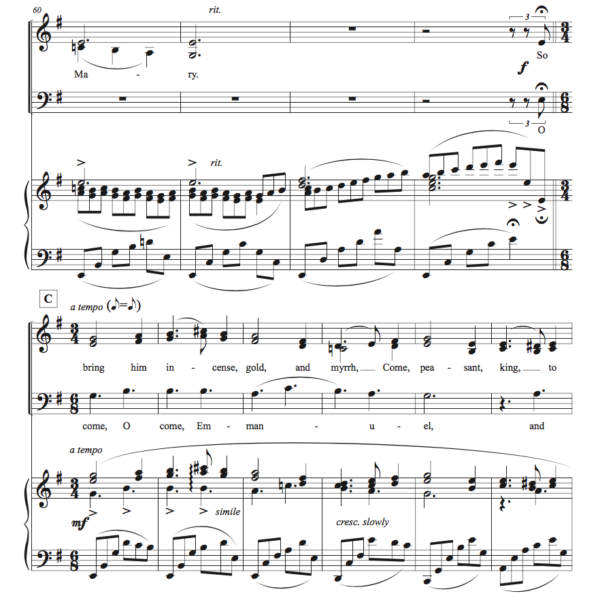“The Child,” composed in December 2015, is one of the piano pieces in the December collection. I imagined it when attending a band concert just before Christmas, which featured one piece on “O Come, O Come Emmanuel” and another on “What Child Is This?” Being played in such close proximity, I wondered if the two pieces would work well together. Both pieces work great in E Minor, and both have similar topics, so I thought it was worth a try.
The big challenge: one is in a triple rhythm, while the other is duple. So, off the bat, I decided to make triple vs. duple a main theme throughout — a technique used often by Brahms and Rachmaninoff.
The first two sections of “The Child” introduce the two tunes separately, and the third section merges the two tunes together, which proved to be a major challenge in composing. I had to choose “What Child Is This?” as the primary theme while hiding “O Come, O Come Emmanuel” in the harmonies. It makes for some very interesting and new harmonies.
This piano piece was a finalist in the 2016 LDS Church Music Submission contest.
In September 2016, when my friend Geoff Groberg suggested that I adapt “The First Noel” for choir, I had the additional idea of adapting “The Child” as well. I wondered how well it would turn out if women sang “What Child Is This?” while men sang “O Come, O Come Emmanuel” in the final combined section. The result is a pretty, yet challenging piece of music to perform.

Practice and Performance Tips: Piano Prelude
The most important advice I can give is: Don’t let the rhythms scare you. Throughout the whole piece the eighth notes in the left hand are constant. Setting a metronome on the eighth note should help you keep everything straight while you practice. In a performance, if you keep it nice and slow, it should work out nicely.
Section 1: “O Come, O Come Emmanuel” is in 6/8 time. That means three eighth notes make up a beat, and there are two beats in a measure. The main melody comes in at measure 5 with a duple rhythm against the (straight) triplets in the left hand. If you are new to playing triplets vs. duples, it may help to count: 1-2-AND-3, where the triplets fall on 1-2-3 / 1-2-3 / etc. and the duples fall on 1-AND / 1-AND / etc.
Section 2: “What Child Is This?” is in 3/4 time, which means two eighth notes in a beat and three beats in a measure. The left hand maintains the same eighth rhythm, but the roles change: triplets in the right hand, duples in the left. The right hand ends up playing faster than before. Just remember, when practicing, the left hand always stays with the eighth notes on the metronome.
Section 3: Combined melodies. The right hand melody is in 3/4 (What Child Is This?), while the left hand and hidden melody is in 6/8 (O Come, O Come, Emmanuel). But don’t let that worry you. Just remember that the left hand continues to play the straight eighth notes along with the metronome, and the right hand goes along for the ride. After a few times practicing, you should begin to feel the rhythms naturally and you won’t need the metronome any longer.
Sound sample – piano version:
Practice and Performance Tips: Choral Version
Before you take on this piece, first realize that it may be one of the most challenging choral pieces we offer. Be prepared for a little bit of work, and the results will be rewarding.
First, you may want to give the accompanist a month or so to practice up their part before adding the choir. See the suggestions above for the piano piece, and then continue on with the following additional suggestions for choir.
Section 1: This part is best conducted in two beats (three eighth notes to a beat). Instruct the men to sing two notes to each conducted beat, and they should do fine after a couple of run-throughs.
Section 2: During the transition, the conductor should switch to conducting in three beats (two eighth notes to a beat). The sopranos sing the normal melody, while the altos sing a mildly jazzy harmony. You will most likely need to rehearse and lock down the alto part.
Section 3: It is probably best to continue conducting in three beats, as the women’s melody is the prominent tune, while the men’s melody should be more of an echo. The conductor may consider trying a modified 4-beat pattern: 1-2-and-3, with an exaggerated “and” to help the men find their beat in the middle of each measure. The rhythms will make this the most challenging section to rehearse, so be ready to run through it several times until the rhythms click. Once everything clicks, you should have a rewarding performance.
Sound sample – Choir version:

Leave a Reply